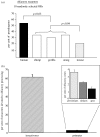Mother-infant bonding and the evolution of mammalian social relationships
- PMID: 17118933
- PMCID: PMC1764844
- DOI: 10.1098/rstb.2006.1940
Mother-infant bonding and the evolution of mammalian social relationships
Abstract
A wide variety of maternal, social and sexual bonding strategies have been described across mammalian species, including humans. Many of the neural and hormonal mechanisms that underpin the formation and maintenance of these bonds demonstrate a considerable degree of evolutionary conservation across a representative range of these species. However, there is also a considerable degree of diversity in both the way these mechanisms are activated and in the behavioural responses that result. In the majority of small-brained mammals (including rodents), the formation of a maternal or partner preference bond requires individual recognition by olfactory cues, activation of neural mechanisms concerned with social reward by these cues and gender-specific hormonal priming for behavioural output. With the evolutionary increase of neocortex seen in monkeys and apes, there has been a corresponding increase in the complexity of social relationships and bonding strategies together with a significant redundancy in hormonal priming for motivated behaviour. Olfactory recognition and olfactory inputs to areas of the brain concerned with social reward are downregulated and recognition is based on integration of multimodal sensory cues requiring an expanded neocortex, particularly the association cortex. This emancipation from olfactory and hormonal determinants of bonding has been succeeded by the increased importance of social learning that is necessitated by living in a complex social world and, especially in humans, a world that is dominated by cultural inheritance.
Figures




References
-
- Amico J.A, Mantella R.C, Vollmer R.R, Li X. Anxiety and stress responses in female oxytocin deficient mice. J. Neuroendocrinol. 2004;16:319–324. doi:10.1111/j.0953-8194.2004.01161.x - DOI - PubMed
-
- Baldwin B.A, Shillito E. The effects of ablation of the olfactory bulbs on parturition and maternal behaviour in Soay sheep. Anim. Behav. 1974;22:220–223. doi:10.1016/S0003-3472(74)80072-2 - DOI - PubMed
-
- Bale T.L, Dorsa D.M. Cloning, novel promoter sequence, and estrogen regulation of a rat oxytocin receptor gene. Endocrinology. 1997;138:1151–1158. doi:10.1210/en.138.3.1151 - DOI - PubMed
-
- Bartels A, Zeki S. The neural correlates of maternal and romantic love. Neuroimage. 2004;21:1155–1166. doi:10.1016/j.neuroimage.2003.11.003 - DOI - PubMed
-
- Barton R. Visual specialization and brain evolution in primates. Proc. R. Soc. B. 1998;265:1933–1937. doi:10.1098/rspb.1998.0523 - DOI - PMC - PubMed
Publication types
MeSH terms
LinkOut - more resources
Full Text Sources
